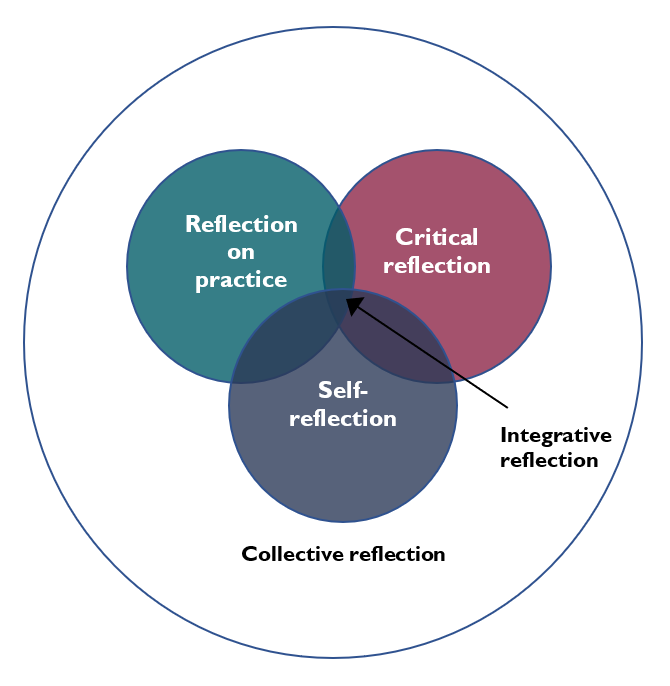Michele Leering has outlined many different types of reflection. You have probably reflected in at least one or two of these reflective domains. You will have likely used reflection to improve your practice, become more self-aware or critically reflect on something.

Reflection on practice – reflecting on how a task is carried out, how well you are developing a skill or how well you are developing legal practice knowledge. It helps you self-assess, understand what you know and do not know, evaluate your effectiveness, investigate new options for practice and articulate the lessons learned. This type of reflection is a baseline for increasing professional competence. You develop metacognition — knowing what you know, understanding how you think and learn — through this type of reflection. You can also consider it like “researching” your own practice, to make sure it is effective and efficient.
At a micro level, for each decision, action or event, we can also sub-divide reflection on practice into three components: Reflection-before-action is thinking through a situation before making decisions or taking action. Reflection-in-action refers to the intuitive way of thinking in the moment. The more experience we gain (with reflection), the better we become at reflection-in-action. Reflection-on-action is reflecting or thinking after an incident or an action.
Critical reflection – This type of reflection includes being vigilant about unpacking our assumptions and questioning our frames of reference. It also includes bringing in new knowledge and ideas to critique how we currently understand things. For example, it includes critically reflecting on whether the law works well, discriminates against your client or reinforces stereotypes, or whether the legal system fosters access to justice for all people.
Self-reflection – This type of reflection involves becoming more self-aware and self-directed, becoming better at regulating your emotions and your behaviour, and being able to articulate your core values. It also implies developing a personal vision and a philosophy of practice, integrating your personal and professional lives, creating a work-life balance, fostering resilience, growing your emotional intelligence, and ensuring ongoing ethical and moral development.
Integrative or integrated reflection – This refers to the ability to integrate the insights from two or more types of reflection; it is not a linear but a spiral process or Venn diagram, as shown in the figure above. It leads to a deepening of insight and knowledge, and action that is more consistent with your values and beliefs. Integrating the domains of reflection can happen in many different ways. For example, you might become aware of the insights from conflict resolution theory, which cause you to critically reflect on your attitudes towards conflict. You then become more self-reflective about your actions — how do you act when exposed to conflict? When you pair together what you’ve learned from conflict resolution theory with your self-reflection, you may decide that you need to change something about your professional practice — for example, how you work with challenging clients, third parties or adversaries.
Collective reflection – The capacity to reflect with others is crucial to ensure the credibility, validity and reliability of your insights, to open them up for scrutiny in the spirit of inquiry and to ensure rigour. Collective reflection is also the method by which we learn from each other, creating new knowledge through dialogue. Collective reflection can happen in many different ways including debriefing, dialoguing with friends, working with a mentor and engaging in peer review. Collective reflection requires being able to accept constructive feedback and to be able to provide it. It requires active listening and building your capacity for dialogue.
Leering defines an integrated reflective practitioner as “… a professional who integrates theory and practice, critically reflects on practice (what one does), and theory (what one knows), and what one believes as a self-directed life-long learner, and then takes action based on that reflection to improve their practice. This kind of professional recognizes the power of reflecting collectively, learning from others and from other disciplines, to enhance professional services, increase professional knowledge, ensure rigour about one’s own reflections, and generate new insights and interdisciplinary knowledge.”
(Leering, 2017, at 49-50)
In the next section, we will explore why reflective practice is an important tool for lawyers.